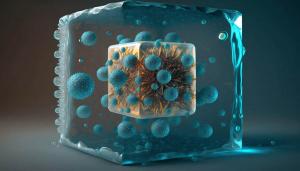Healthcare To Be Blindsided by the Return of Ancient Pathogens
Find out about consequences for human, plant, and animal health as ancient bacteria and virus pathogens are released into the environment.
When we think of anthropogenic climate change, what often comes to mind first are videos of polar ice caps melting and glaciers calving new icebergs into the ocean.
But while melting continental ice sheets and glaciers may grab the headlines, there are other changes taking place in the earth’s cryosphere, such as the extensive thawing of permafrost soils.
Deep soil temperatures have risen by 2 degrees C in the last decade, leading to an abrupt thawing of the permafrost layer (a process known as thermokarst).
As the permafrost layer melts, the ground often subsides, forming wetland areas that can release significant amounts of methane gas (CH4) as the previously frozen organic materials start to ferment. Because methane is a powerful warming agent, this process of warming the cryosphere and thawing permafrost will accelerate as the released methane reaches the atmosphere, reinforcing a vicious circle of global warming.
But there is another hidden danger found in thawing permafrost – it exposes large-scale organic deposits – including potentially deadly ancient viruses and bacteria – for the first time since the Last Glacial Period (LGP) ended about 12,000 years ago.
What Are The Biological Risks To Human Health From Exposing Ancient Pathogens?
What danger do ancient pathogens pose to human health? In other words, are there viruses and bacteria from the pre-ice age era (a time when the earth was warmer) that could wreak havoc on plant and animal life today?
The first question that scientists who study microbial archeology (known as paleomicrobiologists) are asking themselves is what kind of pathogens could survive for millennia in these extreme conditions. Frozen permafrost conditions are harsh, with few available nutrients. The little available moisture is highly saline as well, with a low pH (acidic) and low oxygen levels (anoxic).
Given these extreme conditions, should we be worried about permafrost being a significant reservoir for microbial pathogens?
Yes.
There have already been worrying cases of pathogens being released by thawing ice.
In 2015, two people succumbed to anthrax spores believed to be released from thawing soil in the permafrost tundra of Russian Siberia.
Researchers have discovered reservoirs of ancient Influenza A RNA in a frozen Siberian lake that could be transmitted to migratory birds. Scientists have also identified a frozen animal (anthropoid) RNA virus and a plant DNA virus in the Canadian Arctic.
The concern is that, to mix metaphors, these discoveries might be the tip of the iceberg – and that many more ancient microorganisms and viruses hidden in permafrost could emerge, posing a risk to modern-day humans, animals, and plants.
Can We Inherit Immunity To Ancient Viral Pathogens That Infected Humans In The Past?
But are these “ancient” pathogens really “new” (or, in pandemic terms, “novel”?)
In other words, just how potentially vulnerable are modern humans, plants, and animals vulnerable to the re-emergence of old pathogens?
Lab researchers are finding evidence that, in the case of humans, there are instances where we may inherit immunological protection from viral infections that affected our ancestors.
One research team led by George Kassiotis, head of the Retroviral Immunology Laboratory at the Francis Crick Institute in London, found that, during the Covid pandemic, 43% of children had significant Covid antibodies before infection, compared to only 5% of adults. The theory posed in the paper published by Kassiotis’ team is that, in the case of Covid, young people are inheriting the immune system “memory” of similar infections passed down from earlier generations.
Read more...
Julia Solodovnikova
Formaspace
+1 800-251-1505
email us here
Legal Disclaimer:
EIN Presswire provides this news content "as is" without warranty of any kind. We do not accept any responsibility or liability for the accuracy, content, images, videos, licenses, completeness, legality, or reliability of the information contained in this article. If you have any complaints or copyright issues related to this article, kindly contact the author above.


